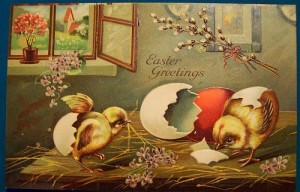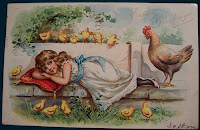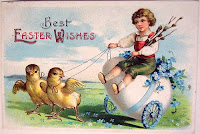
Since the earliest times, spring and the renewal of life after winter have been celebrated around Easter. Most people know Easter as a Christian holiday that marks the resurrection of Jesus.
But here are Easter facts you might not know:
Ancient Links: Venerable Bede (circa 672-735) believed Easter was derived from Eostre, an Anglo-Saxon goddess of spring. This ancient goddess was called many names, including Ostare, Ostara, Ostern, Eastur and Austron.
Some scholars – particularly the British historian Ronald Hutton – aren’t completely convinced that Bede’s evidence conclusively links Easter with this goddess and a pre-Christian festival. But some facts appear certain: April was called Estor-monath (or something similar) in Germanic languages around Bede’s time. And the Anglo-Saxon word eastre is linked to several Indo-European words signifying dawn.
In other words, new beginnings have been celebrated around this day for a very long time.
Spring Equinox: Easter is held on the first Sunday – after the first full moon – after the spring equinox. If Easter Sunday falls on the full moon, the holiday is postponed until the following Sunday. That means Easter can occur any time March 22 to April 25. The sequence is so complicated that it takes 5.7 million years to repeat.
Time for the New: Want good luck for the year? Then wear something new on Easter. Otherwise, you’ll be sorry, according to this old proverb:
“At Easter, let your clothes be new;
Or else be sure you will it rue.”
Easter Bunny: It has long been said that fertile folks can “breed like rabbits.” No wonder many ancient cultures associated rabbits and hares with fertility, regeneration and spring. Old folklore believed rabbits cured sterility or difficult pregnancies. Even now it’s considered good luck to carry a rabbit’s foot. Perhaps the only ones who don’t consider rabbits a lucky symbol are the gardeners who have seen their flowers and vegetables devoured by the furry critters.
Immigrating Germans brought the Easter bunny to the United States. But the tradition wasn’t widely adopted in this country until after the Civil War.
Easter Eggs: It’s hard to imagine Easter without eggs. Yet, this tradition has roots that extend back to the earliest known civilizations. In fact, eggs represented rebirth and fertility to many ancient cultures.
As Ronald Hutton writes in Stations of the Sun: A History of the Ritual Year in Britain, “The bird’s egg has always been one of the most ubiquitous human symbols of new life in general and of spring in particular.” Ancient Greeks, Persians, Egyptians and Romans exchanged eggs during spring festivals.
In 1290, the household of British King Edward I purchased and decorated 450 eggs in gold leaf to distribute among his royal entourage. By the 1600s, Germans were exchanging decorated eggs at Easter – especially among young lovers. In Central and Eastern Europe, egg decoration has become a true art form. Ukrainian Easter eggs – called “pysanka” – are especially popular. Learn more from the Ukrainian Museum.
And who can forget the fabulous Faberge eggs created for the Russian Tzars? Diamonds, rubies, emeralds and sapphires adorned these exquisite eggs that often depicted important moments in Russian history.
Green Easter: Looking for ways to celebrate Easter in a more earth friendly way? Then hop on over to Huffington Post for lots of green ways to celebrate this spring holiday.
Images Credit: The lovely vintage Easter cards illustrating this post came from an amazing collection belonging to riptheskull on flickr.com.














{ 12 comments }
Thanks for the link to Faberge eggs. I didn’t realize they were created in connection with Easter (I just thought the guy liked egg shapes).
Yes, you could call these jewel-studded Faberge creations the ultimate Easter egg…
As familiar as I am with the long history of Easter (having been a pagan) it’s still always nice to read it again. Thanks.
Thanks, Kim and Victoria. I’m always amazed how many commonalities exist between various cultures and their seasonal celebrations…
This information is so interesting. Thanks. I don’t think I knew or at least remembered why Easter was always on a different date each year.
thank you for this post! I loved reading it!
Thanks for your comments, Gwynn and Yvette. Sometimes history really is stranger than fiction.
Thanks for another informative post. I love the very ancient foundations for so many of our "modern" holidays. It makes them more meaningful, somehow — that they sprang from the deepest impulses of the human psyche. And nature, of course.
Helen: You are absolutely right. Many of our holidays spring from much older times… and it's a nice way to connect to our innate connection with nature. Thanks for stopping by. Teresa
Thanks for the fun historical facts about Easter. I once was given a Ukranian Egg Making kit. Wow, what a challenge it was to make, but SO well worth it. Thanks for mentioning them.
Love the history and I love your blog Happy Easter to you and yours and I’ll see you in Arkansas Annie
Kathy and Annie: Thanks for your nice comments. Is it any wonder that we love to celebrate Easter? The holiday falls at such a nice time of the natural year, doesn’t it?
Comments on this entry are closed.
{ 3 trackbacks }